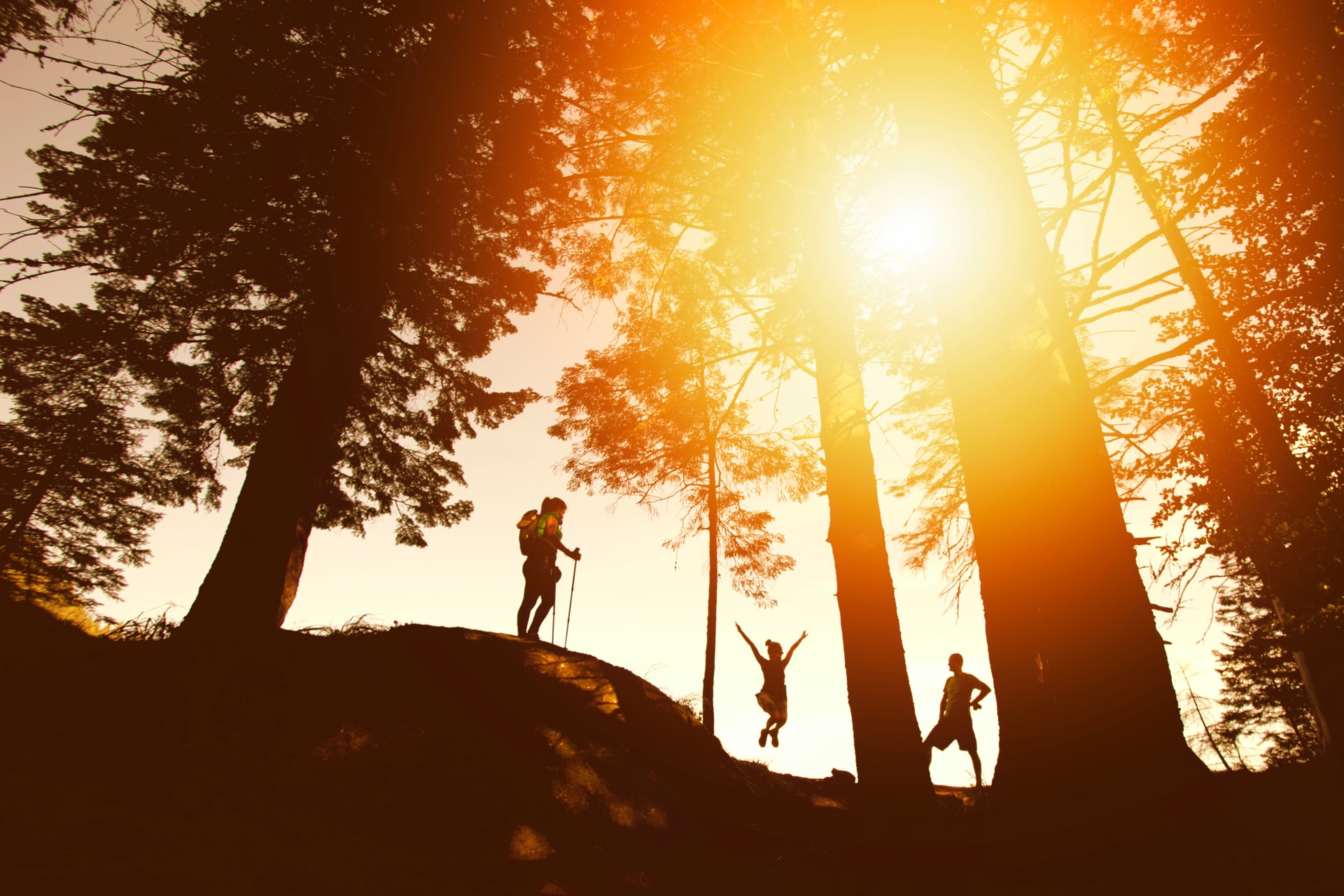Cooler fall temperatures are made for hiking. Whether you’re taking a short walk in the woods or setting off on a longer trail, there are 10 essential things you need on a day hike.
Hiking backpack with water bladder
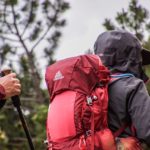
A hiking backpack with a water bladder makes your hike safer and easier. Hiking backpacks have many small pockets and pouches and are ideal for stashing all your hiking gadgets, plus your phone, keys, identification…you get the idea. Beyond that, most hiking backpacks have an insulated compartment for your water bladder. Staying hydrated while hiking is vital for your health.
Typical water bladders hold about 1.5 liters or about 50 ounces of liquid. They have a tube that threads through a hole in the backpack, over your shoulder, and hangs close to your mouth for easy and frequent hydration. I guarantee you’ll grow tired of carrying a bottle of water, end up stashing it in your backpack, and not drink as often as you should.
Both the backpack and the water bladder with a sipping tube allow you to go hands-free. If your hiking trail has you scrambling over rocks and trees, and navigating inclines and slopes, staying hands-free to help keep your balance also keeps you safe.
Extra socks

At the end of a long hike, changing into clean dry pair of socks not only feels good, but it’s a must. Your feet contain more than 250,000 sweat glands, which produce about half a pint of perspiration per day. Keeping your feet in a sweaty cramped environment invites all manner of fungus, plus it just feels uncomfortable.
Before you even put on a pair of socks and pack an extra pair, it’s worth noting what kind of socks you should be wearing at all. Good hiking socks, like those made from merino wool or another synthetic fabric wick moisture away from your skin. Don’t hike in cotton socks. Period. Cotton acts as a sponge, keeping moisture close to your skin.
When your feet get wet, you’re prone to blisters, which can turn a good hike into a trek of misery. What’s more, wet feet become cold feet very quickly. And that’s a recipe for frostbite.
Rain poncho
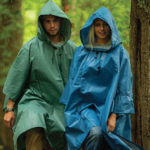
You’re probably thinking a rain poncho is a heavy plastic tarp-like garment that (a) could never fit into a backpack, and (b) something you’d never need. And you’d be wrong. To be fair, there are rain ponchos that are insulated, which naturally makes them heavier. But if you’re going on a day hike, you can pick up a lightweight rain poncho that folds up to the size of a paperback novel (remember those?), which can easily fit into your backpack.
No one expects rain on a well-planned hiking trip, but it can happen. If it does, staying dry can become a matter of life or death. As with wet feet, wet clothes can lead to cold, and cold can turn to hypothermia. A rain poncho will not only keep you dry but will also keep your backpack dry as well. Keeping your gear dry is just as important as keeping you dry.
Multitool
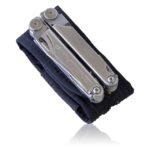
A multitool is your insurance policy. While on a day hike, it’s unlikely you’ll use it to saw tree limbs or fend off bears. However, a multitool is useful for a variety of smaller situations you may potentially encounter, such as getting a zipper unstuck, pulling out a splinter, cutting rope, opening bottles, or make minor repairs to your gear.
For the size, cost, and amount of space it takes up, better to have it and not need it than need it and not have it.
Toilet paper and zip lock bags
Bet you never thought you’d find this on a list of the 10 essential things you need on a day hike.
Let’s face it. Nature will always call at the most inopportune times. And it’s very rare to find bathroom facilities on a hiking trail. Yet, when you gotta go, you gotta go. And if you do, don’t leave your ‘cleaning’ materials behind assuming that paper is biodegradable.
Our county, state, and national parks are forest belong to everyone and no one. Together, we must assume collective responsibility for the lands we enjoy. That means picking up after yourself and leaving no trace of ever having traveled through.
So, when you gotta go, pack some rolled-up toilet paper and a zip lock bag to carry your waste off the trail with you.
High protein high carb snacks

Hands down, my all-time favorite hiking food is simple peanut butter and jelly sandwich. Protein and carbs are the perfect foods to keep my strength and energy up for a long hike. My favorite hiking memory perched on a rock 11,000 feet in the air in Rocky Mountain National Park eating a well-deserved peanut butter and jelly sandwich.
Not a fan of PB&J? Look for other high-protein portable snacks like beef jerky or beef sticks, nuts (almonds, shelled pistachios, and walnuts), or rolled-up turkey breast lunch meat. Portable healthy carbs include things like blueberries, apple slices, and grapes.
Walking poles
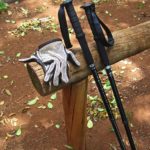
Whether walking poles are essential is debatable. However, with my surgically repaired and arthritic knees and hips, walking poles have provided profound benefits. An extra set of limbs is helpful when navigating up inclines. Walking poles also provide stabilization when going downhill, and provide balance when scrambling over downed trees. Plus, they come in handy for clearing spider webs out of your face.
I certainly could have used a set when I tore my ACL while hiking. I foolishly went off-trail in my quest for a Geocache navigated out of some thick forest. Instead, I had to make do with a log that wasn’t nearly as useful and tore up my palm in the process.
Trail map and compass
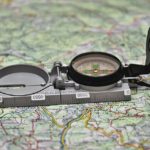
Trail maps are a necessity before venturing out on a hike. Maps orient you if you get lost or turned around on a trail. Yes, many apps do exist which make them electronically available, but the further you get away from civilization, the less likely you are to have a cell signal to pull up that map.
Many county, state, and federal park websites have detailed trail maps you can download and print before you go. It’s a good practice to grab one this way since the park offices may either be closed, or one may not exist at your trailhead at all.
In addition, spend some time learning how to use a compass. Again, electronic devices may not work when we need them to, and being able to go “old school” to read a compass and compare that to your trail map can get you out of a bind quickly.
First aid kit and whistle
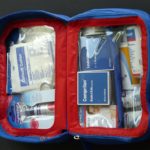
You might think that you have no need or space for a first aid kit in your hiking backpack. And you’d be wrong.
When out in the wilderness, whether you’re in a thick forest, on a desert trail, or a casual stroll on a well-worn path through an urban park, trips, stumbles, scrapes, cuts, bug bites and bee stings can and do occur. It’s best to have gear with you to clean up, cover-up, and stabilized a wound until a more thorough cleaning or medical attention can be gotten.
A whistle is an overlooked and essential item to take with you on a day hike. Hiking solo? A whistle will save your life if you were to be injured on a hiking trail. Your voice carries only so far, and you’ll be horse long before you are found. The sound of a whistle, on the other hand, carries much farther. Whistles are ridiculously inexpensive, so there’s no reason not to have one in your hiking backpack.
Final Words
Fall is the time of year that absolutely beckons one to take a hike through the glorious change of seasons. Be safe and prepared by packing these 10 things to take with you on a day hike. While you may never need any of them, you’ll be grateful if you do.

